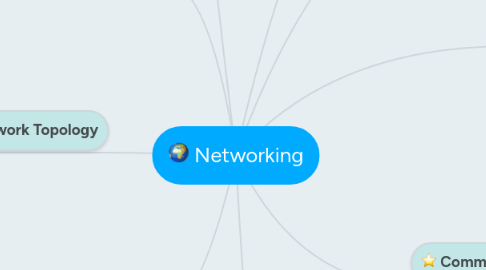
1. Forms of networks
1.1. Local area network (LAN)
1.1.1. connects computers and devices in a limited geographical area
1.2. Wireless LAN (WLAN)
1.2.1. a LAN that uses no physical wires
1.3. Wide area network (WAN)
1.3.1. a network that covers a large geographical area
2. Network Topology
2.1. refers to the layout of computers and devices in a communications network
3. Network Communication Standards
3.1. Ethernet
3.1.1. Specifies no computer controls when data can be transmitted
3.2. Token Ring
3.2.1. specifies that computers and devices on the network share or pass a special signal (token)
3.3. TCP/IP
3.3.1. defines how messages are routed from one end of a network to another
3.4. Bluetooth
3.4.1. defines how two Bluetooth devices use short-range radio waves to transmit data
3.5. UWB (ultra-wideband)
3.5.1. specifies how two UWB devices use short-range radio waves to communicate at high speeds
3.6. IrDA
3.6.1. transmits data wirelessly via infrared (IR) light waves
3.7. RFID
3.7.1. uses radio signals to communicate with a tag placed in or attached to an object, animal, or person
4. Wireless Transmission Media
4.1. Cellular radio
4.1.1. a form of broadcast radio that is used widely for mobile communications
5. Advantages
5.1. Facilitating communication
5.2. Sharing hardware
5.3. Sharing data and information
5.4. Sharing software
5.5. Transferring funds
6. Networks
6.1. A collection of computers and devices connected together via communication devices and transmission media
7. Communication Devices
7.1. any type of hardware capable of transmitting data, instructions, and information between a sending and receiving device.
7.1.1. A hub or a switch connects several devices in a network together
7.2. Dial-up modem
7.2.1. Converts signals between analog and digital
7.3. Digital modem
7.3.1. Sends and receives data to and fro a digital line
7.3.2. DSL modem
7.3.3. Cable modem
7.4. Wireless modem
7.4.1. uses the cell phone network to connect to the internet wirelessly from a notebook etc
7.5. Network Card
7.5.1. enables a device to access a network
7.5.2. available in a variety styles
7.6. Router
7.6.1. connect multiple computers and transmits data to its correct destination on a network
8. Communications Channel
8.1. Bandwidth
8.1.1. the amount of data that can travel over a communications channel
8.2. Latency
8.2.1. the time it takes a signal to travel from one location to another
8.3. Broadband
8.3.1. media transmit multiple signals simultaneously
8.4. Transmission media
9. Open System Interconnection Model (OSI model)
9.1. !st layer - Physical Layer
9.1.1. eg. Ethernet, USB
9.2. 2nd layer - Data Link Layer
9.2.1. eg. PPP, ATM, Ethernet
9.3. 3rd layer - Network Layer
9.3.1. eg. IP, ARP
9.4. 4th layer - Transport Layer
9.4.1. eg. TCP, UDP
9.5. 5th layer - Session Layer
9.5.1. eg. NetBIOS, PPTP
9.6. 6th layer - Presentation Layer
9.6.1. eg. SSL, TLS
9.7. 7th layer - Application Layer
9.7.1. eg. HTTP, FTP, DNS

